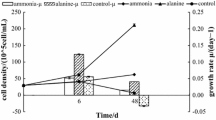Abstract
The toxic effects of La3+ on Tetrahymena thermophila have been studied by microcalorimetry at 28°C. The metabolic rate constant (r) and peak time were linked to the concentration of La3+. The changes of metabolic rate constant indicated that low-concentration La3+ (0–75 mg/L) had no significant effects on the metabolism of Tetrahymena cells but high-concentration La3+ (100–175 mg/L) could inhibit their metabolism. From the results obtained by cell counting and fluorescence depolarization measurements, the inhibition of metabolism resulted from the decrease in cell number and the reduction in cell membrane fluidity. According to the results, it is clear that the metabolic mechanism of Tetrahymena cells has been changed with the addition of high-concentration La3+. In addition, microcalorimetry of Tetrahymena could be a sensible, easy-to-use, and convenient method for monitoring the potential effects of rare earth elements on cells and the freshwater ecosystem.




Similar content being viewed by others
References
Shen YF (1990) Modern biomonitoring techniques using freshwater microbiota. China Architecture and Building, Beijing
Twagilimana L, Bohatier J, Groliere CA, Bonnemoy F, Sargos D (1998) A new low-cost microbiotest with the protozoan Spirostomum teres: culture conditions and assessment of sensitivity of the ciliate to 14 pure chemicals. Ecotoxicol Environ Saf 41:231–244
Fillingham JS, Chilcoat ND, Turkewitz AP, Orias E, Reith M, Pearlman RE (2002) Analysis of expressed sequence tags (ESTs) in the ciliated protozoan Tetrahymena thermophila. J Eukaryot Microbiol 49:99–107
Turkewitz AP, Orias E, Kapler G (2002) Functional genomics: the coming of age for Tetrahymena thermophila. Trends Genet 18:35–40
Sauvant MP, Pepin D, Piccinnt E (1999) Tetrahymena pyriformis: a tool for toxicological studies. Chemosphere 38:1631–1669
Yang WD, Wang T, Lei HY, Liu JS, Yang YS (2000) Progress in studies on biological effects of rare earth. Chin Rare Earths 21:62–70
Sato T, Hashizume M, Hotta Y, Okahata Y (1998) Morphology and proliferation of B16 melanoma cells in the presence of lanthanoid and Al ions. J Biometals 11:107–112
Wu HF, Zhang XY, Li XJ, Li ZF, Wu YJ, Pei FK (2005) Studies on the acute biochemical effects of La(NO3)3 using 1H NMR spectroscopy of urine combined with pattern recognition. J Inorg Biochem 99:644–650
Shi P, Huang ZW (2005) Proteomic detection of changes in protein synthesis induced by lanthanum in BGC-823 human gastric cancer cells. Biometals 18:89–95
McGulnness MS, Georges BB (1991) Acute toxicity measurements on aquatic pollutants using micromicrocalorimetry on tissue-cultured cells. Environ Sci Technol 25:1092–1098
Zhao RM, Liu Y, Qu SS (2000) A micromicrocalorimetric method for studying the biological effects of La3+on Escherichia coli. J Biochem Biophys Methods 46:1–9
Liu P, Liu Y, Deng FJ, Peng DW, Qu SS (2003) Microcalorimetric investigation of the effect of La3+on mitochondria isolated from avian chicken liver tissue cells. J Therm Anal Cal 73(3):843–849
Beermann K, Buschmann HJ, Schollmeyer E (1999) A microcalorimetric method for the rapid evaluation of toxic substances using Tetrahymena pyriformis. Thermochim Acta 337:65–69
Lin KC, Nie SQ, Bo HQ (1981) The study on membrane fluidity of the ascites tumor cells by fluorescent probe DPH. Prog Biochem Biophys 6:32–35
Gustafsson L (1995) 1994 and all that: ecology in a calorimeter!. Thermochim Acta 51:69–70
Yao J, Liu Y, Liu P, Gao ZT, Sun M, Qu SS, Yu ZN, Shen YF (2003) Micromicrocalorimetric investigation of the effect of manganous(II) on the growth of Tetrahymena shanghaiensis S1 99. Biol Trace Elem Res 92:71–82
Liu JK (1999) Advanced hydrobiology. Science, Beijing
Hu QH, Ye ZJ (1996) Physiological effects of rare-earth elements on plants. Chin Plant Physiol Commun 32:296–300
Liu P, Liu Y, Xie ZX, Shen P, Qu SS (2003) Micromicrocalorimetric studies of the toxic action of La3+on Halobacterium halobium R1 growth. Chin J Chem 21:693–697
Zhang JR, Zhu LC, Yang XX, Lu KR, Sheng GQ, Dai TJ (2003) Effects of propofol on plasma membrane fluidity in PC12 cells and liposome. Chin J Clin Pharmacol Ther 8:129–132
Kuhry JG, Fonteneau P, Duportail G, Maechling C, Laustriat G (1983) TMA-DPH: a suitable fluorescence polarization probe for specific plasma membrane fluidity studies in intact living cells. Cell Biophys 5:129–140
Swan TM, Watson K (1997) Membrane fatty acid composition and membrane fluidity as parameters of stress tolerance in yeast. Can J Microbiol 43:70–77
Shi YZ, Chen JW, Huang F (1994) The effects of rare earth ions on anion transport ability of band 3 proteins and membrane fluidity of resealed ghost. Acta Biophys Sin 10:591–596
Hauser H, Hinckley CC, Krebs J, Levine BA, Phillips MC, Williams RJ (1977) The interaction of ions with phosphatidylcholine. Biochim Biophys Acta 468:364–367
Conti J, Halladay HN, Petersheim M (1987) An ionotropic phase transition in phosphatidylcholine: cation and anion cooperativity. Biochim Biophys Acta 902:53–64
Acknowledgments
We would like to express our gratitude to Prof. Xi Li and Dr. Peng Liu for providing the TAM microcalorimeter in Wuhan University of Technology. The authors gratefully acknowledge the financial support of the National Natural Science Foundation of China (no. 30170136).
Author information
Authors and Affiliations
Corresponding authors
Rights and permissions
About this article
Cite this article
Xiaojuan, C., Weisong, F., Yuhe, Y. et al. Studies on the Toxic Effects of La3+ to Tetrahymena thermophila by Microcalorimetry. Biol Trace Elem Res 123, 242–249 (2008). https://doi.org/10.1007/s12011-008-8092-0
Received:
Accepted:
Published:
Issue Date:
DOI: https://doi.org/10.1007/s12011-008-8092-0



